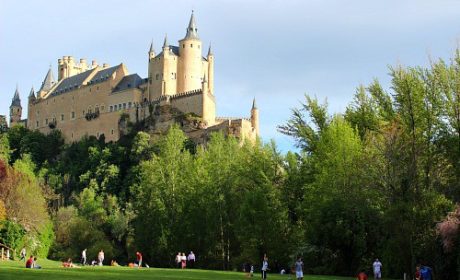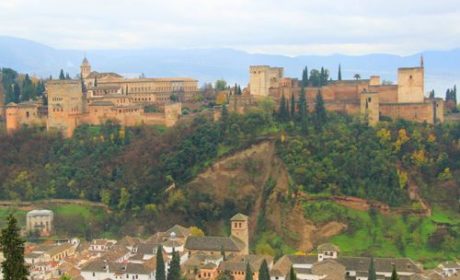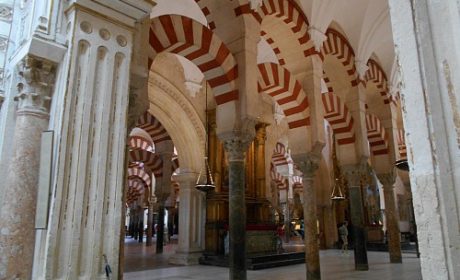European travel is obviously near and dear to our hearts, and, of course, Spain is always on our radar, especially the country’s many off-the-beaten-track destinations. Today, guest contributor and local resident, Rachel Webb from Andalucia Explorer, is here to show us the ins and outs of Jaen travel, a beautiful town carpeted with olive groves and history located in the heart of Andalucia.
Everyone has heard of Granada, Cordoba and Sevilla the three most famous and well-visited cities in Andalucia but what about Jaen? Jaen province (pronounced a gutteral ‘Hi-En’) sits atop Granada and Cordoba provinces and to the north is the Andalucia and Castilla-La Mancha regional border.
It’s name comes from the Moorish ‘Geen or Yayan’ meaning, way or passing of caravans and often these days it’s still passed by en-route from north to south or Madrid to the Costa del Sol.
It’s now twenty years since the local tourist association named it ‘Paraiso Interior’ – Inland Paradise and it also happens to be twenty years since I moved there too!

Within its borders, Jaen province is home to Spain’s largest Natural Park – Parque Natural de Cazorla, Segura y Las Villas is an impressive area of wild flora and fauna, winding mountain roads and stunning views. It is also the source of the mighty Guadalquivir River which flows across to the Atlantic Ocean passing through Cordoba and Sevilla.
Unesco Ubeda and Baeza
Just on the edge of Cazorla Natural Park are two lovely Unesco-twinned Renaissance towns Ubeda and Baeza, both of which are very much worth a visit.

Jaen also has the largest man-made forest comprised of a veritable sea of olive groves, which produce a huge part of the economy in the fabulous form of liquid gold – Olive Oil. Local tradition and gastronomy are based on olive oil. History flows through time, originating from the first trees that were planted by the Romans, and poured onto today’s tapas, which are still given free of charge.

The regimented rows of olive trees march across the province, 66 million or so of them only interrupted by lovely, unspoilt white mountain villages dotted across mountains and settled into valleys giving a languid peace to the whole area. Inland Paradise – a green sea of calm.
Land of Castles and Battles
This area is also the land of castles, watchtower and fortresses. Many towns and villages can be spotted from a distance thanks to their landmark towers. This mountainous landscape is rife with semi-ruins. Restored fortresses and lonely towers are long-lasting signs going back to the ages of the Visigoths, Jews, Romans, and Moors, to the more modern use as a strategic base for the Napoleonic Troops. There is a route across the province – Castles & Battles Route (Ruta de Los Castillos y Batallas) that takes you north to south via the most important historical dates and sites.
Jaen Castle and Parador
I’m going to take you around the city, my nearest city, as I do my family and my guests. First a leisurely, scenic drive on the way to Jaen city. Follow the signs to Parador de Santa Catalina, Jaen’s fortress-style Parador Hotel (a state-run, luxury hotel) perching above the city. It’s a great place to stay but we’re going for coffee (or a beer, depending on the time of day) to see the lovely building with it’s enormous vaulted ceiling.

Then we walk along the ridge of the hill on the walkway passing the mighty castle entrance, doorway to the castle ruins with visitor centre, once a hospital for Napoleon’s men. It has some interesting insights into its history and fabulous views, which if there’s time, we’ll go and explore.

Continuing on the walkway the hill drops away both sides with dramatic crags behind and Jaen city spreading out in front as we approach the huge white monumental cross with views reaching as far as the Sierra Nevada mountain range in Granada. The cross is said to have been built in the exact spot where the Moors were finally defeated as part of the Christian Reconquest by King Fernando III in 1246.
The town unfurls at the base of the hill, the older part closer to its base is easily distinguishable by the smaller houses and old Moorish roof tiles. Then the centerpiece Jaen’s Renaissance Cathedral, a gigantic landmark that holds court in the middle of the city.
Jaen City
Returning to the car, we’ll drop down into town and explore below what we saw from above. The cathedral even more daunting when standing on the plaza in front of it. Full of treasures amazing architecture and religious treasures is well worth the small entry fee.
If you’re planning a trip to this beautiful area, make sure to check out a list of hotels in Jaen.
After wandering the narrow streets of the Jewish district, imbibing in several tapa stops in the atmospheric food market will be needed. One necessary stop is the 1888 bar El Gorrion, which has barely changed since opening. It’s a time-warp ( think western saloon!) brown and dingy with decades of tabacco smoke, incredible ancient photos on the walls, a mummified jamon (in a glass case) which is said to be at least 80 years old, simple tapas, plus locally prepared olives (of course), wine out of old wooden casks and your bill chalked on the chunky wooden bar top. A must experience for one drink or maybe two but definitely not for dinner.
Heading into the old quarter and to the Palacio de Villardompardo, we stroll around a 16th century palace now home to two museums, Naïve and Primative Art and a Traditions and Costumes Museum. Below the palace, at one time filled in and now, forgotten about, is a near-complete, award-winningly renovated 11th century Arab Baths.
Visitors to Spain should make sure to see Granada, Cordoba and Sevilla, but Jaen holds it own as far as history, culture, and of course, culinary excellence. Jaen shouldn’t be passed over, so next time you’re in Spain, make sure to take time to explore this wonderful destination!
Have you ever explored Jaen? Come join the conversation at the My Itchy Travel Feet page on Facebook. Or send us an email with your thoughts.



